Publications
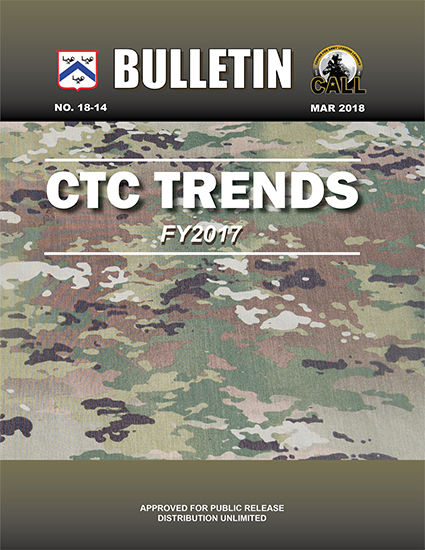 18-14 - CTC Trends FY2017 Bulletin
18-14 - CTC Trends FY2017 Bulletin
This CTC Trends Bulletin identifies trends for fiscal year 2017 across the CTCs, based on observations from observer-coach/trainers (OC/Ts) and collection and analysis teams from the Center for Army Lessons Learned (CALL), with support from various Army Centers of Excellence. A trend is defined in Army Regulation 11-33, Army Lessons Learned Program (14 JUN 2017), as "an identified issue or best practice supported by three or more observations from multiple sources within a reasonable period." CALL collects observations, best practices, and training results from OC/Ts at the CTCs; analyzes them; and compiles them annually in a publication. Organized by Army tactical tasks from the Army Universal Task List, these CTC trends reflect both positive performance (sustains) and areas that need emphasis (improves). CTC trends provide valuable information to units developing and executing training for deployment to a CTC or an operational environment. Each chapter includes recommendations for units to successfully execute identified tasks. This provides a reference for training emphasis at home station. Additionally, identifying and analyzing trends allow doctrine writers, training developers, and other Army problem solvers to receive successful techniques and identify gaps in capability for doctrine, organization, training, materiel, leadership and education, and personnel and facilities (DOTMLPF) solutions. Applying the lessons learned at the unit or the institutional level from trends that are identified enables the Army to be a continually learning organization.
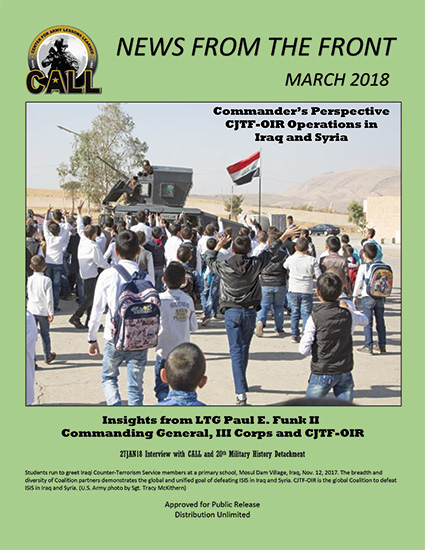 NFTF: Commander’s Perspective CJTF-OIR Operations in Iraq and Syria
NFTF: Commander’s Perspective CJTF-OIR Operations in Iraq and Syria
On 17 October 2014, the Department of Defense formally established Combined Joint Task Force - Operation Inherent Resolve (CJTF-OIR) in order to formalize ongoing military actions against the rising threat posed by the Islamic State of Iraq and Syria (ISIS). III Corps assumed authority from XVIII Airborne Corps on August 2017. Since its inception CJTF-OIR, Coalition, Syrian and Iraqi partnered forces working together have made enormous progress denying ISIS aspirations. This NFTF is a reflection on that progress and the evolution of the battlefield.
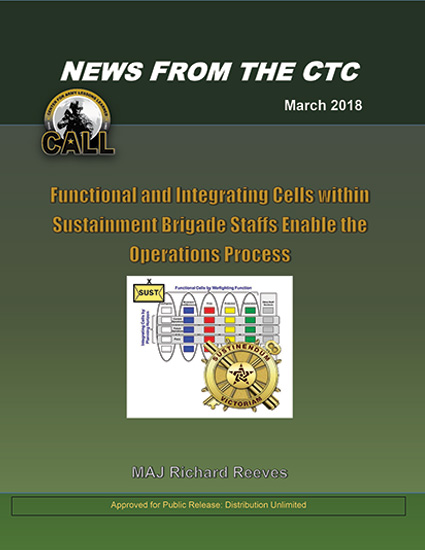 News From the CTC: Functional and Integrating Cells within Sustainment Brigade Staffs Enable the Operations Process
News From the CTC: Functional and Integrating Cells within Sustainment Brigade Staffs Enable the Operations Process
This article is primarily intended for Army sustainment officers and NCOs who are newly assigned to a sustainment brigade staff. Such individuals, having spent the majority of their careers (so far) down in companies or battalions, are often unaware of the processes and procedures they must undertake to successfully accomplish their mission.
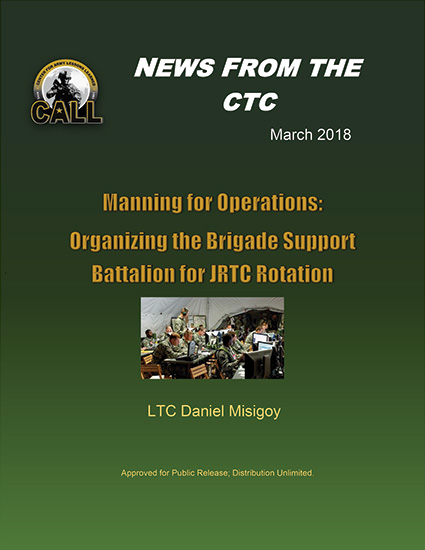 News From the CTC: Manning for Operations: Organizing the Brigade Support Battalion for JRTC Rotation
News From the CTC: Manning for Operations: Organizing the Brigade Support Battalion for JRTC Rotation
Organizing the Brigade Support Battalion for JRTC Rotation The purpose of this article is to describe how the 225th Brigade Support Battalion organized its forces to support Task Force Warrior during JRTC 17-04. The article will focus on how the unit’s organization deviated from the MTOE, and what risks were assumed and why
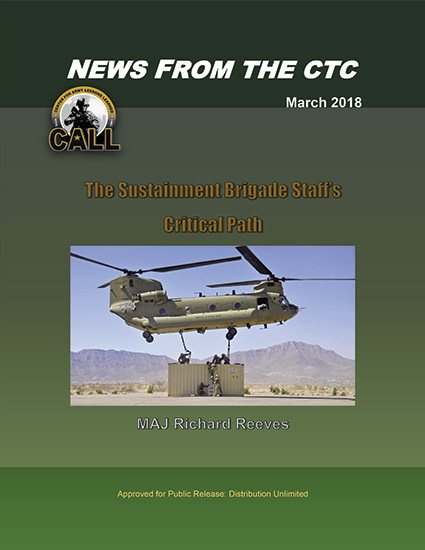 News From the CTC: The Sustainment Brigade Staff’s Critical Path
News From the CTC: The Sustainment Brigade Staff’s Critical Path
This article is primarily intended for Army sustainment officers and NCOs who are newly assigned to a sustainment brigade staff. Such individuals, having spent the majority of their careers (so far) down in companies or battalions, are often unaware of the processes and procedures they must undertake to successfully accomplish their mission.
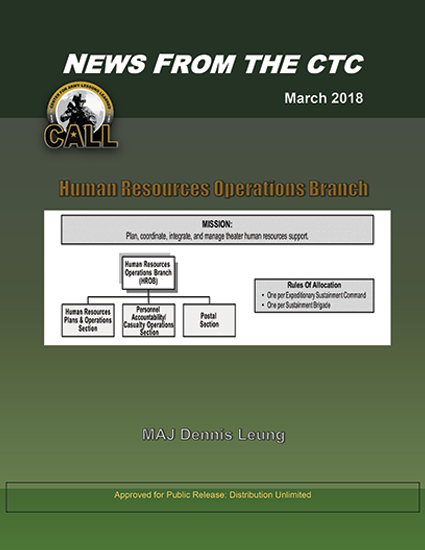 News From the CTC: Human Resource Operations Branch
News From the CTC: Human Resource Operations Branch
The Human Resource Operations Branch (HROB) is a resource manager within the support operations (SPO) section of a Sustainment Brigade (Sus BDE) or Expeditionary Sustainment Command (ESC) responsible for enabling human resource operations within a theater of operations and facilitates the management of our most precious commodity - personnel. However, outside of a deployment, HROBs are seldom employed, and when deployed, HROBs are rarely manned and operated with the experience and technical expertise to be effective.
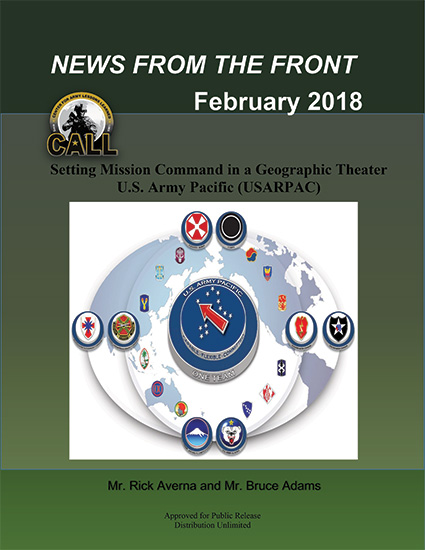 NFTF - Setting Mission Command in a Geographic Theater U.S. Army Pacific (USARPAC)
NFTF - Setting Mission Command in a Geographic Theater U.S. Army Pacific (USARPAC)
Establishing mission command systems is an essential component to setting a geographical theater for military operations and is a core function of the Unites States Army Pacific (USARPAC). Doing so in advance of any contingency operation ensures continuous mission command, and allows headquarters and facilities to be identified, emplaced, and systems to be rehearsed routinely in order to seamlessly command and control Army forces throughout a theater. An Army service component command (ASCC) must set the following mission command conditions: clear lines of command, support relationships, and authorities and the physical structure which allows commanders to have the uninterrupted ability to communicate throughout the depth and breadth of the geographic theater.
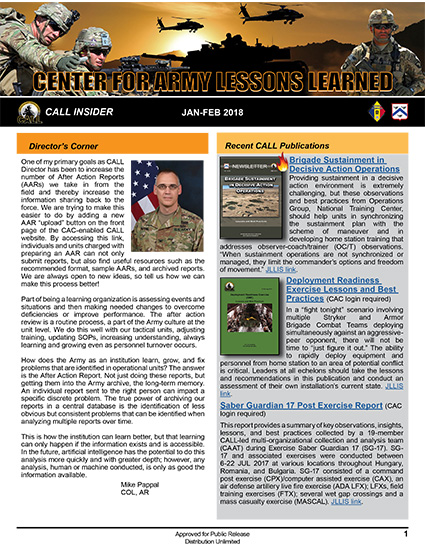 CALL Insider Newsletter Jan-Feb 2018
CALL Insider Newsletter Jan-Feb 2018
CALL Insider Newsletter Jan-Feb 2018
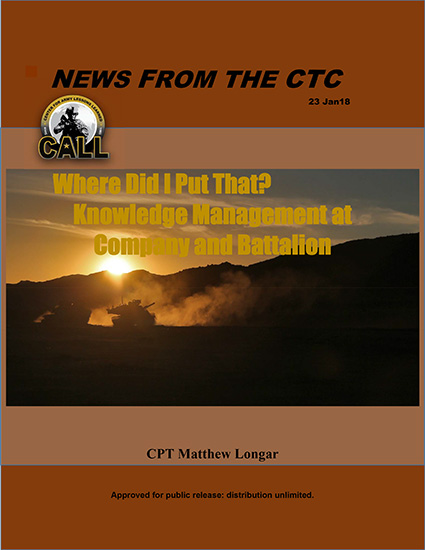 News From the CTC: Where Did I Put That? Knowledge Management at Company and Battalion
News From the CTC: Where Did I Put That? Knowledge Management at Company and Battalion
This article is intended for all units conducting home station training to prepare themselves for a combat training center (CTC) rotation. The author discusses a recurring trend at the Joint Readiness Training Center (JRTC) that one of the more significant debates during JRTC rotations seems to be the challenge of analog versus digital products. While each method has its own merits, each presents its own challenges as it relates to KM. Thus, each method should have associated techniques for ensuring effective knowledge flow to higher, subordinate, and adjacent headquarters.
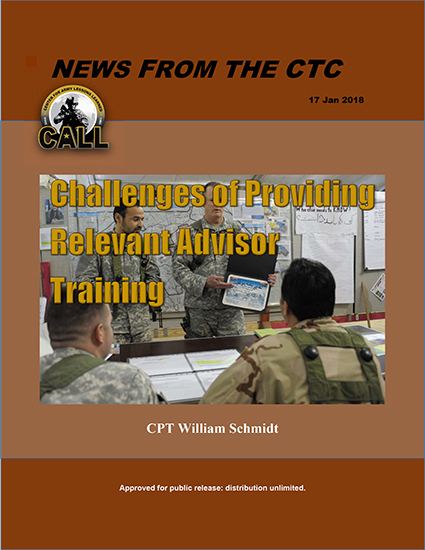 News From the CTC: Challenges of Providing Relevant Advisor Training
News From the CTC: Challenges of Providing Relevant Advisor Training
The author discusses some of the challenges that the Security Force Assistance (SFA) academy faces as one of the staple courses of the 3-353rd AR BN for preparing future advisors. The goal of the academy is to teach the two categories of individual advising skills: Enabling Skills and Developing Skills.
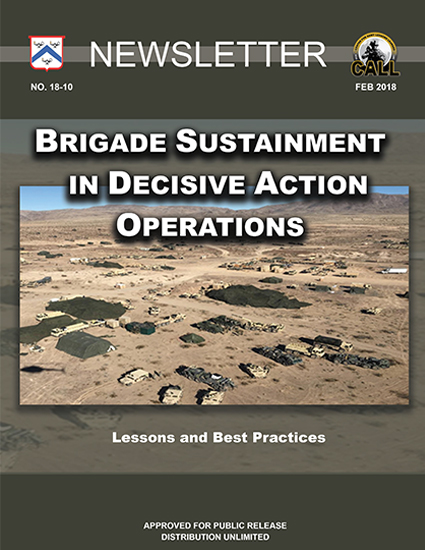 18-10 - Brigade Sustainment in Decisive Action Operations Newsletter
18-10 - Brigade Sustainment in Decisive Action Operations Newsletter
The following collection outlines observations and best practices from the National Training Center (NTC). It exposes the challenges of providing sustainment in a decisive action environment but should assist units to tie the sustainment plan with the scheme of maneuver. It should also help develop home station training to address current gaps and shortfalls observed at the NTC.
The topics examined in this newsletter include the following: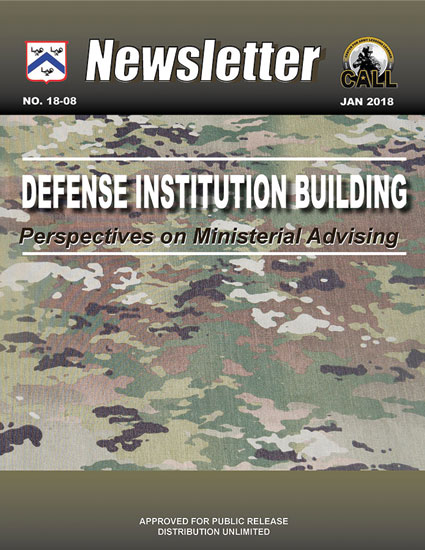 18-08 Defense Institution Building Perspectives on Ministerial Advising Newsletter
18-08 Defense Institution Building Perspectives on Ministerial Advising Newsletter

